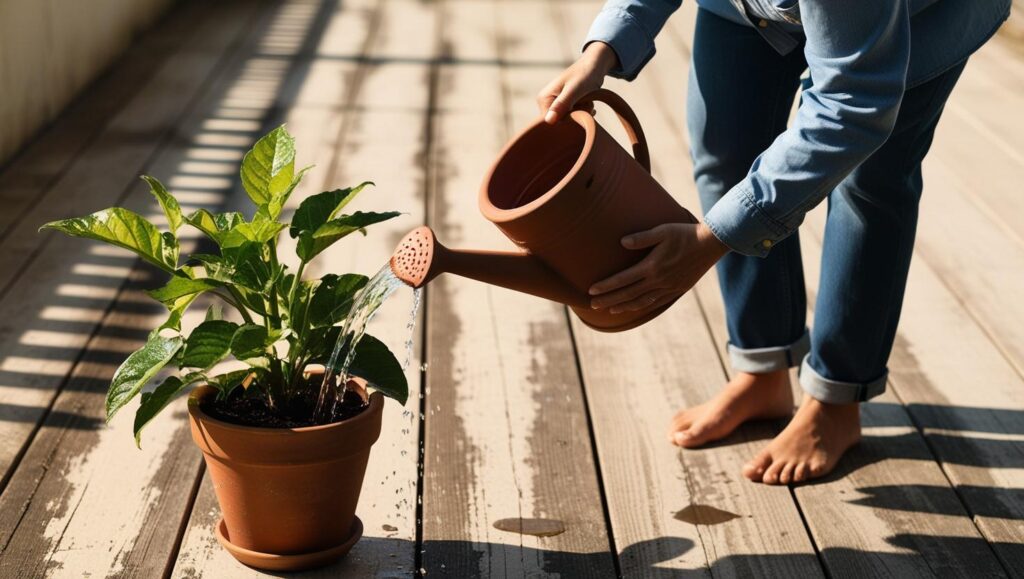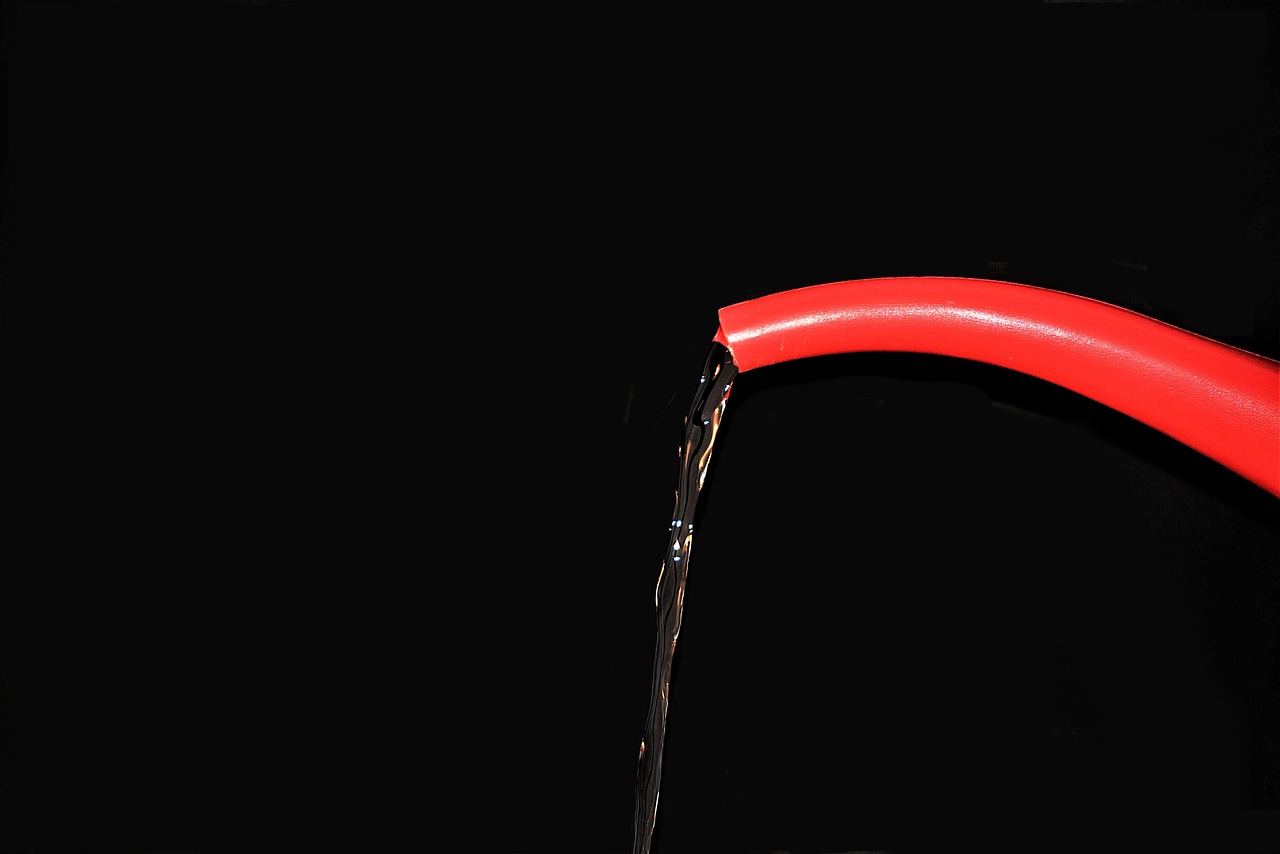Watering is a crucial aspect of houseplant care, but did you know that there’s more than one way to hydrate your green friends? Different plants require different watering techniques, and understanding these techniques can make a huge difference in your plant’s health. In this guide, we’ll explore various watering methods, along with their pros and cons, to help you choose the best one for your plants.
Let’s dive into the world of watering techniques and discover how to keep your plants hydrated and thriving!
1. Top Watering (Traditional Watering)
How It Works
Top watering is the most common and straightforward method. It involves pouring water directly onto the soil surface from above, either with a watering can, jug, or hose. The water then flows through the soil, hydrating the roots.
Pros:
- Simple and Accessible: Most people are familiar with top watering, and it doesn’t require any special equipment.
- Effective for Most Plants: This method works well for many indoor plants, especially those in small pots or with fast-draining soil.
- Quick to Apply: Top watering is fast and easy, which is great if you’re short on time.
Cons:
- Can Lead to Overwatering: If you’re not careful, it’s easy to overwater. Water can sometimes sit on top of the soil or in the pot’s saucer, promoting root rot.
- Leaves Can Get Wet: Water splashed onto leaves or stems can promote fungal growth, leading to diseases like powdery mildew or rot.
- Not Ideal for Plants with Sensitive Roots: Plants with delicate roots, like ferns or succulents, may not like being watered from above.
Best For:
- Plants in small pots
- Plants with well-draining soil
- Houseplants that don’t mind occasional moisture on their leaves

2. Bottom Watering
How It Works
Bottom watering involves filling a tray or saucer with water and placing the plant pot in it. The plant absorbs water through the drainage holes at the bottom of the pot, allowing the soil to wick up moisture gradually.
Pros:
- Prevents Overwatering: Since the plant absorbs water at its own pace, it’s less likely to get too much water.
- No Wet Leaves: Bottom watering keeps the leaves dry, which reduces the risk of fungal infections and leaf rot.
- Good for Plants Sensitive to Overhead Watering: Plants with sensitive root systems (like succulents or cacti) benefit from this method.
- Encourages Deep Root Growth: This technique encourages roots to grow downwards, which helps develop a stronger root system.
Cons:
- Takes Longer to Absorb: Bottom watering can take a while for larger plants, and it may not be as quick as top watering.
- Requires Proper Drainage: For this method to work effectively, the pot must have drainage holes. Without them, water can’t reach the roots properly.
- Not Ideal for All Plants: Some plants, particularly those with very compact or dense roots, may struggle to absorb enough water from the bottom.
Best For:
- Plants with sensitive or shallow roots (e.g., succulents, ferns, African violets)
- Small to medium-sized pots
- Plants that need to avoid wet leaves
3. Self-Watering Pots
How It Works
Self-watering pots have an integrated reservoir at the bottom of the pot, which holds water. The pot’s soil sits above the reservoir, and a wick system allows the water to move upward into the soil as needed, keeping it consistently moist.
Pros:
- Convenient and Low-Maintenance: Self-watering pots are great for busy plant owners because they reduce the need for frequent watering.
- Prevents Overwatering: The soil only absorbs as much water as it needs, which prevents both overwatering and underwatering.
- Maintains Consistent Moisture: The wick system provides a steady supply of water, making it easier to keep the plant hydrated for long periods.
- Ideal for Vacation or Travel: These pots are perfect for when you’re away, as they keep plants watered without any additional effort.
Cons:
- Can Lead to Root Rot if Left Too Long: While they prevent overwatering in most cases, if left in standing water too long, self-watering pots can still encourage root rot.
- Not Suitable for All Plants: Plants that require dry periods between waterings, such as succulents, are not ideal for self-watering pots.
- Can Be Expensive: Self-watering pots are often pricier than traditional pots.
Best For:
- Busy plant owners
- Plants with medium to high water requirements (e.g., tropical plants, herbs)
- People who travel frequently or tend to forget to water
4. Watering Globes or Spikes
How It Works
Watering globes or spikes are devices that slowly release water into the soil over time. A globe is inserted into the soil, or a spike is attached to a water bottle. As the soil dries out, the globe or spike releases water to hydrate the plant.
Pros:
- Convenient for Absentee Plant Care: Perfect for short-term watering when you’re away, as they can keep the soil moist for days or weeks.
- Consistent Moisture Supply: They provide a slow, steady supply of water, reducing the risk of underwatering.
- Easy to Use: Just fill the globe or bottle, and it does the rest.
Cons:
- Not Ideal for Long-Term Use: While convenient for a few days, watering globes or spikes aren’t a sustainable solution for regular plant care.
- Can Lead to Root Rot if Overused: If the globe or spike is releasing too much water, it can cause the soil to become soggy, promoting root rot.
- Not Suitable for All Plants: Some plants may not like constant moisture at their roots, and the device might not provide enough water for larger or more thirsty plants.
Best For:
- Plants that need frequent hydration but not constant watering
- Vacation watering (short-term care)
- Small to medium-sized plants
5. Irrigation Systems (Automatic Watering Systems)
How It Works
Automatic watering systems, often used for larger collections of plants, consist of a system of tubes and drippers connected to a water source (e.g., a reservoir or tap). The system automatically waters plants on a preset schedule.
Pros:
- Great for Large Collections: Perfect for plant owners with many plants, as it automates the watering process.
- Customizable: You can set the system to water at specific times and adjust the flow for different plants.
- Time-Saving: Ideal for busy plant owners, as the system handles the watering automatically.
Cons:
- Initial Setup Cost: There’s a cost involved in purchasing and setting up an irrigation system.
- Requires Monitoring: While automatic, the system still needs occasional maintenance to ensure proper functioning.
- Not Ideal for Small Plant Collections: For a small number of plants, this system might be overkill.
Best For:
- Plant owners with a large collection of plants
- Greenhouses or larger indoor gardens
- Busy people who want a set-it-and-forget-it watering solution
6. Mist Watering
How It Works
Mist watering involves lightly spraying water on the leaves and soil using a spray bottle. It’s often used for plants that prefer high humidity, such as tropical plants.
Pros:
- Increases Humidity: Great for plants that thrive in humid environments, like ferns, orchids, and calatheas.
- Keeps Dust Off Leaves: Regular misting can help clean the leaves and prevent dust buildup.
- Easy to Control: You can adjust the frequency and amount of mist depending on the plant’s needs.
Cons:
- Not a Substitute for Soil Watering: Misting isn’t a replacement for watering the soil. It only adds moisture to the air and surface of the plant.
- Can Lead to Fungal Growth: If done excessively, misting can encourage mold or mildew, especially if the air isn’t well-ventilated.
- Doesn’t Hydrate the Roots: Misting only affects the leaves and doesn’t provide deep hydration to the plant’s roots.
Best For:
- Plants that require high humidity (e.g., ferns, orchids, calatheas)
- Plants in dry indoor climates
- Plants with a preference for foliar feeding or humidity
Conclusion: Choosing the Right Watering Technique
There’s no one-size-fits-all method for watering houseplants—each plant has its own unique needs. By understanding the pros and cons of different watering techniques, you can choose the best method for your specific plants.
- Top watering works for most houseplants, but be careful not to overwater.
- Bottom watering is great for sensitive roots and avoiding wet leaves.
- Self-watering pots are convenient for low-maintenance care, but may not be suitable for all plants.
- Watering globes or spikes are a quick fix for short-term watering, like when you’re away.
- Irrigation systems are ideal for large collections and busy plant owners.
- Mist watering is perfect for humid-loving plants but doesn’t replace soil watering.

